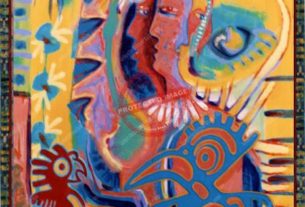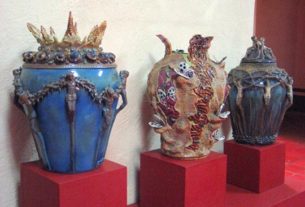Patrick Dennis found me in Sullivan Park, just behind El Monumento de la Madre in Mexico City, one fine Sunday, and changed my life.
His buddy, Nina Olds, Gore Vidal’s mother, and my mother’s buddy and neighbor in Southampton for years had asked him to check me out, “for Sue”. Was I a starving artist, or was I making a living? Were my children clothed and fed, faces washed? Watch and see if I had any clients, if I sold anything? What were my paintings like? And so on……
So Patrick ambled over to Sullivan Park from his splendid house in Calle Tabasco one Sunday. He sat on my client bench for several hours, eyeing the activity down his nose and causing my clients to write their checks standing up. I couldn’t help but notice him; he had a diamond stickpin in his ascot at ten-thirty in the morning. The little army of shoe-shine boys stood around him admiringly. He had already allowed two of them to polish his spotless shoes. I thought, he must be an art lover, hope springing eternal.
Sullivan Park’s Jardin del Arte was my lifeline. It was the only place in Mexico where foreigners were allowed to display and sell their art, and, most importantly, tax-free. I was the only Gringa. It was very hard to get into because over the years the directors had accepted just about anybody to swell their ranks and fill the spacious park with artists and easels to attract the tourists. Good and bad paintings seemed to sell in the same numbers. There was truly a painting for everyone…but some cost a lot more than others. Sullivan Park now had over three hundred artists, most of them pretty bad. Over the years they had gotten a lot of bad press and harsh criticism from the collectors who prowled the park every Sunday, so they got very selective in their new entrance applications. They had to.
After the Cuban Revolution, when half of the Cuban refugees came to Mexico on Student Visas, [the half that didn’t go to Miami], Mexico canceled its Student Visa policy and made them all get FM-2 books. That meant me, too. That’s how I had snuck in. Lots of the Cubans left Mexico for Miami at that point because they couldn’t meet the stiff financial requirements. I went into Sullivan Park.
Every Sunday, I showed up in Mexico City on a bus from Cuernavaca, about eight o’clock in the morning. Federico was under one arm, forty paintings, tied together, were under my other arm. My chair and umbrella [for some shade] dangled from various parts of my body. I never drove a car in Mexico in those days because I was an illegal and couldn’t get a license. Federico and I were usually back on our bus, bound for Cuernavaca, by one o’clock in the afternoon, paintings all sold.
Although I was in no way a starving artist, I had learned to live very quietly and unobtrusively in my role of reverse wetback. I signed my work “Maria Elena” [instead of Mary Ellin], hoping to confuse Inmigracion if they ever stooped to investigating foreign artists. Every week, I worked on my crop of forty paintings, never coming out of the woodwork except on my Sullivan Sundays. It took me twenty-two years to get my FM-2 book and become legal. I thought I would die of happiness. I was in Sullivan Park only a few years, but my gratitude remains for its haven in the first few years of “Maria Elena”, and for all the painters and clients who had become good friends.
Little did I know that this fine looking gentleman with the stickpin would become one of them. Just before I started up to go, he introduced himself. “The Patrick Dennis?” I gasped. I knew immediately that he had been sent as Super Spy from my mother. Thank God he had seen my paintings being gobbled up and could report back favorably. Thank God Federico was nattily dressed in miniature bell bottoms, his face washed. He had spent most of his morning sitting on the other end of the client bench, watching the shoe-shine boys watch Patrick.
Patrick was all charm. He and my mother had been gossiping and drinking buddies for many years, in the theatre and out. I had heard much about him , overheard, really, since my stepfather thought he was one of my mother’s more disgraceful friends, but I had never laid eyes on him. I thought he lived in Southampton, or surely in New York, watching over his various “Auntie Mame” productions and signing autographs. Amazingly, he lived less than a mile away, in Mexico City.
He confessed his spy activities and asked my pardon. I knew he wouldn’t dream of not obeying Mother or Nina. He admired Federico. He said he loved my pictures and did I have any others, but larger? I said, yes, but I lived in Cuernavaca and couldn’t manage them with Federico, and my maid Maria absolutely refused to work Sundays. I babbled on. Patrick asked if he could come to my house to see them? Now? So he called his houseman to bring the car around and Federico, Patrick and I all went home to Cuernavaca in style.
From that day on, Patrick was my buddy too. He bought countless paintings, God only knows what he did with them all. He all but became my agent, dragging people to Sullivan Park every Sunday. I think I was his only sober, shy friend. His friends intimidated me and shocked me. He signed his checks for my paintings “Edward Tanner”, his real name, and I felt I knew a secret. I confessed that because I was still stuck in the Saturday Children’s Matinee at the Cine Morelos, I had never seen his “Auntie Mame”, although I had read the book. We sat through a private showing of the movie, at Bellas Artes, no less, and I told him that Mame reminded me of Mother on her pleasant days. He cackled delightedly. I hope he never told her, she would not have appreciated it.
Patrick loved art, his house was full of paintings and objets d’art. He loved artists and introduced me to such hot-shots as Jose Luis Cuevas and Leonora Carrington. I, in turn, introduced him to Rufino Tamayo and his wife, David Siqueiros and Annette Nancarrow. He was thrilled with the gentle Tamayo, and especially his wife. Siqueiros’ brusk manner and ripeness offended him. I thought that he would be thrilled to meet Annette because she had been the model for Rivera, Orozco and Siqueiros many years ago but he and Annette were at different poles and eyed each other with distaste.
True, he was sarcastic, bitchy and hilarious, but he was also very very kind. It was he who told Victor Salmones and E.G.McGrath about me and my work was in their prestigious gallery for years. Eventually I graduated from Sullivan Park into the gallery world. Still illegal, my galleries paid my taxes for me as I had no cedula [like a Social Security Number]. The government didn’t care who paid the taxes as long as they got paid.
I missed seeing Patrick on my bench on Sundays, I missed Sullivan Park, although it had been a hard grind every Sunday. But I was working hard and my boys were turning into young men. I never went to Patrick’s parties anymore, they rather scared me. By now, we had a six-bedroom house and two yellow VW’s and Mother lived in Cuernavaca too, about four miles away. Each year she came down for the Cuernavaca winter season when she had finished with the Southampton summer season. She rented a different beautiful house every year, the only requisite being that it was good for parties and had great servants. I led a quieter life altogether. Out of all the thousands of gringos residing in Cuernavaca, I was probably the only one who worked. The others all managed their money, another form of work entirely, and one that I would probably never know.
It was Mother who kept me up on Patrick. He had been ill and went home to wherever he had come from, and died. There was a little piece about it in the Sunday New York Times, which Mother got religiously, but I only got the Mexico City News and it wasn’t mentioned although he had spent many years and lots of money in Mexico.
Patrick, like my mother, was sassy and self-destructive and they both snuffed out their candles at both ends, but they had a very good time doing it, and most of their wounds were self-inflicted. I don’t forget you, Patrick, wherever you are, and I’ve seen both your “Auntie Mame” and “Mame” movies countless times on cable, as have my children and grandchildren. I always tell them that if it were not for you, I would still be painting forty paintings a week


